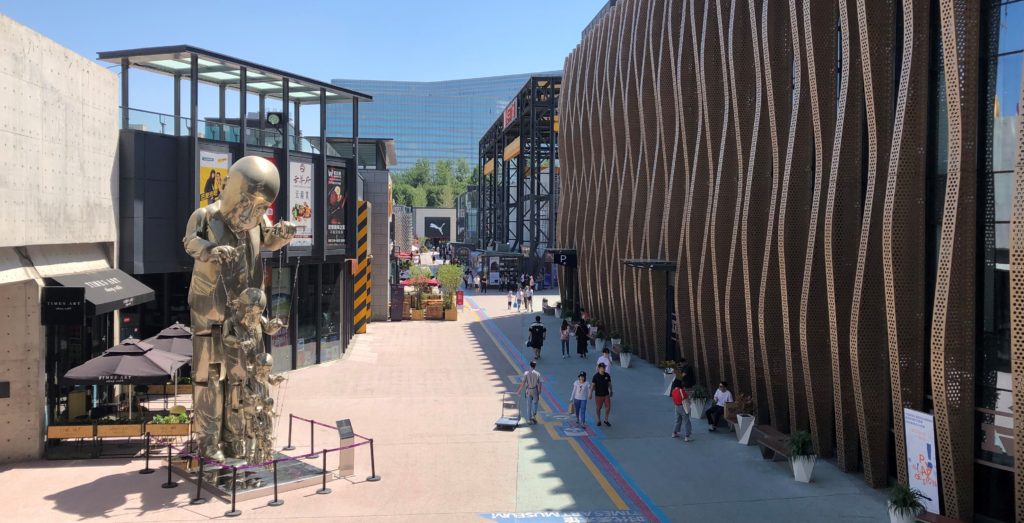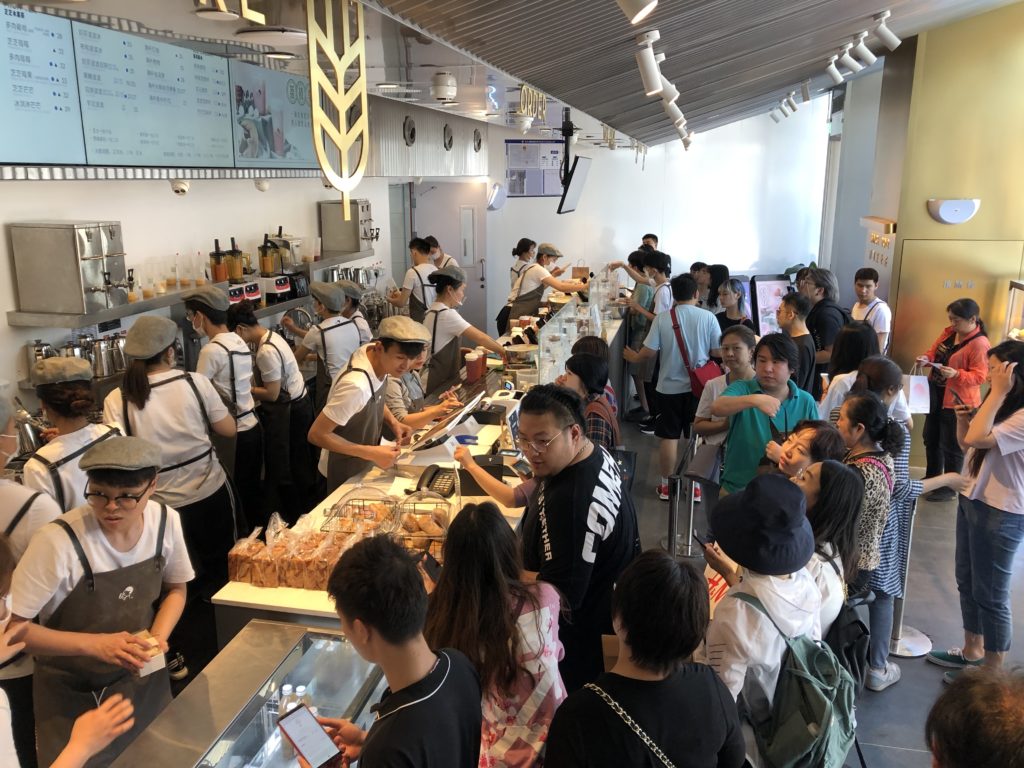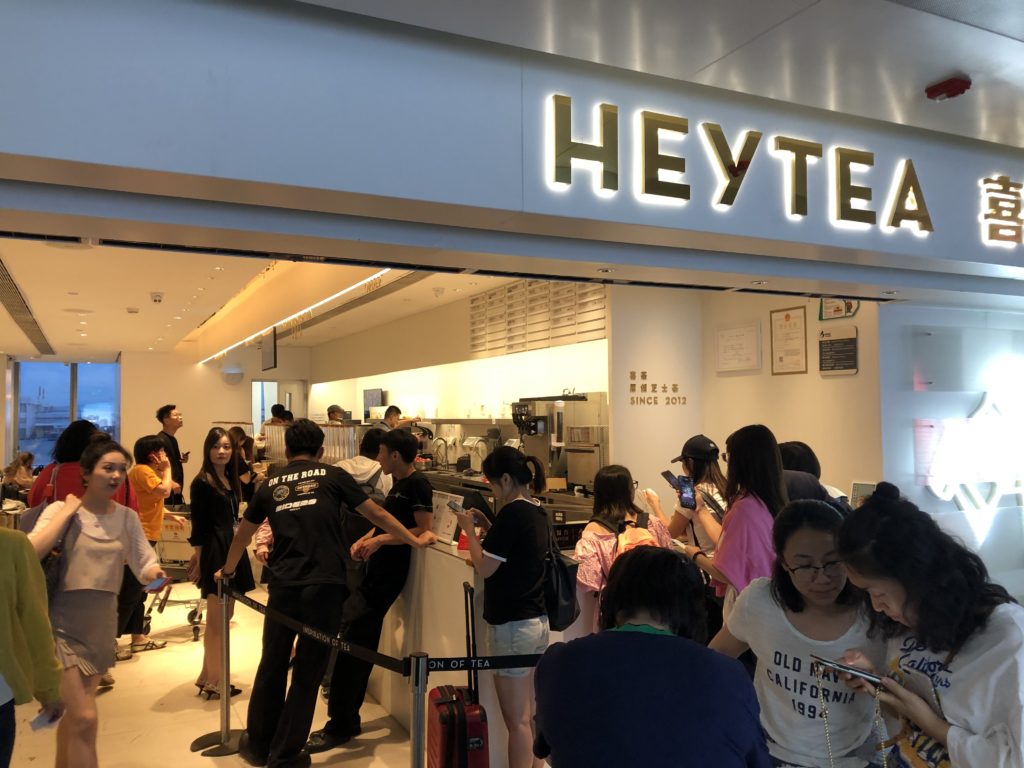In Part 1, I argued that Starbucks China most interesting competitor is not Luckin Coffee. It is HeyTea, an upscale Starbucks-type business focused on tea (something Chinese consumers really, really like).
And to their credit, HeyTea appears to be mostly focusing not on digital innovation but on product development and continually thrilling their customers. Which leads me to my next reason for why you should keep an eye on HeyTea.
Reason #3: They Have Lines Out the Door.
A few years ago, I met HeyTea Chief of Staff Joy Tan at a newer upscale shopping mall in Western Beijing. And as it was in the afternoon, sp most of the restaurants and cafes were empty.
But arriving at the HeyTea outlet I could see a line out the door. In fact, you could see it from across the mall. Tons of empty stores and then one store with a line out the door. Note: Making an impression like that in F&B is pretty important.
And inside, it was packed.
However, a quick caveat. Long cues in China don’t always mean what you think.
One of my standard questions to MBA students in China is: What does it mean when you see one restaurant with a line out the door?
The international students always say “well, that one is popular”.
The Chinese students always say “they are paying people to stand there.”
And both can be true.
- A couple of years ago, it came out that movie studios in China were paying people to go to cinemas on opening weekend to boost their numbers. They were paying people to fill seats.
- KOLs routinely buy online traffic to make themselves appear popular.
People hear that the movie was sold out. Or that this influencer is popular. So they go to the movie and it becomes a self-fulfilling prophecy.
Some of these tactics include just faking numbers and being dishonest. Totally true. But a lot of this is about being perceived as popular in an intensely competitive market.
And there is what Warren Buffett calls the “institutional imperative”. If your competitor is doing something like this, you have a strong push to do it as well. If a competing movie is launching the same weekend as yours and the press is reporting they are sold out (by paying to fill seats), that is going to impact your movie. You can either do the same or you can watch your movie tank.
If I was running a restaurant in China (I have been involved in two restaurants in the past), I would be pulling every clever trick I could think of to get people in the door and to create the appearance of being popular.
Anyways, it’s something to keep in mind.
In the case of HeyTea, I went to three outlets in Beijing and it was definitely real demand. All three were packed with lines out the door. I even went to one in the Beijing airport at 8pm at night – and it was also packed (see below).
HeyTea and high-priced, creative tea drinks are an interesting consumer phenomenon. And speaking with Joy, she mentioned that most of their stores were operating at capacity. People hold places in line for other people, which has resulted in the average order being three drinks (and about 80rmb). And managing their long cues is turning out to be a real challenge. Long lines can impact the consumer experience.
Reason #4: They Are Growing Based on Traffic – not Investor Capital.
HeyTea has grown from +220 outlets to 3,000 in about 5 years. That’s great. And that is how successful retailers and F&B are supposed to grow. They open outlets, build traffic, get them to operating break-even and then open some more. You pay very close attention to same store sales.
And that is exactly how Starbucks, KFC and McDonalds originally grew in China. It took Starbucks twenty years to get to 6,500 outlets. They did lose money for the first 8 years and they routinely close stores based on profitability. But it is overall a story of organic growth against real demand. Their annual store closures in China have been much less than in the US.
The first iteration of Luckin Coffee was an attempt to grow like a tech company. They used venture capital money to open +2,000 outlets in their first year of operations. This could have been them taking advantage of their more scalable business model (90% of their outlets were just for pick-up). But it was more an exercise in financial engineering. They built something that venture capitalists liked, show them big growth numbers and then went public fast. Even without the fraud, it was a higher risk strategy that doesn’t make sense in non-tech.
Anyways, I am old school. I like the HeyTea organic approach. They have raised some private funding rounds but are not buying customers. I like to see slow expansion based on foot traffic. I like to visit stores and count people walking in over a couple of hours.
Reason #5: They Are Well-Positioned to Move into Coffee, Caffeine and Sugar.
F&B is a difficult business, with fickle consumers, endless competition and few durable advantages. So how do you win?
The answer from HeyTea was to have a 10/10 product that your customers love. To have unbelievable product market fit. And then to innovate as much as possible in the consumer experience.
Dominant Starbucks had a different answer.
They pushed caffeine and sugar. They are not selling beverages. They are selling stimulants. Caffeine is pleasantly addictive and creates a strong daily habit. That is what gets you them their stable core customer base that comes in every day.
Yes, the drinks are good. But so are juices, milk and most other beverages. It’s mostly about the caffeine and sugar, which virtually every one of their drinks is loaded with. Starbucks, Coke, Red Bull and 5 Hour Energy are all mostly in the stimulant business.
So what about doing this in tea?
Most green and black tea has very little caffeine or sugar in it. People like regular, fruit and bubble teas but they don’t need to get one first thing every morning. I argued to Joy they should offer a morning “energy tea”. Basically take one of their popular teas and load it with 150mg of caffeine. Make it addictive and daily habit.
Interestingly, HeyTea has started to coffee products. They offer a matcha and a brown sugar coffee (a cool name). I think they are experimenting in this regard. I think any movement towards coffee, caffeine and sugar could be really interesting.
Final Reason: HeyTea Is Set Up to be Acquired or IPO.
As mentioned, F&B in China is mostly about thrilling your customers. And HeyTea’s ability to do this is very rare.
The other part is getting the real estate right. Starbucks is awesome at this in China. They have great locations in first and second tier cities. They are always in the high traffic and high visibility locations. And their outlets are fantastic. Most are like modernized versions of traditional Chinese tea houses. Note: They are far better than the dingy Starbucks in the USA.
HeyTea has been copying Starbucks approach in both locations and quality of design. They are going after good locations in Grade A shopping malls. You can find them literally next door in Starbucks in places like San Li Tun in Beijing. And their interiors are pretty great. They mostly have three store concepts: black industrial retro, white and pink.
But real estate is a game of operational scale. It takes a long time to build a footprint of quality locations. And it has slowly become one of HeyTea’s core skills. There are very good at creating popular products. And they are getting better at the real estate aspects.
If HeyTea continues on their current trajectory, I think they are set up to IPO or be acquired. Perhaps by Yum! China or maybe even Starbucks. And there are lots of real estate, supply chain and marketing benefits to scale. We’ll see.
***
That’s basically my take. If you couldn’t’ tell, I am pretty scared of the whole F&B sector. I’m burned from personal experience. I find it really difficult and success is rare. So Luckin and HeyTea are good companies to watch. They are succeeding the the world’s most competitive F&B market.
Cheers, jeff
———-
Related articles:
- Lessons in Digital Operating Basics from Ram Charan. Part 1 of 2 on “Rethinking Competitive Advantage”. (Asia Tech Strategy – Podcast 98)
- Meituan vs. Ctrip vs. Alibaba: Who Will Win in China Services? (Jeff’s Asia Tech Class – Podcast 22)
From the Concept Library, concepts for this article are:
- Retail Tech
From the Company Library, companies for this article are:
- Starbucks
- HeyTea
- Luckin Coffee
———
I write, speak and consult about how to win (and not lose) in digital strategy and transformation.
I am the founder of TechMoat Consulting, a boutique consulting firm that helps retailers, brands, and technology companies exploit digital change to grow faster, innovate better and build digital moats. Get in touch here.
My book series Moats and Marathons is one-of-a-kind framework for building and measuring competitive advantages in digital businesses.
Note: This content (articles, podcasts, website info) is not investment advice. The information and opinions from me and any guests may be incorrect. The numbers and information may be wrong. The views expressed may no longer be relevant or accurate. Investing is risky. Do your own research.



